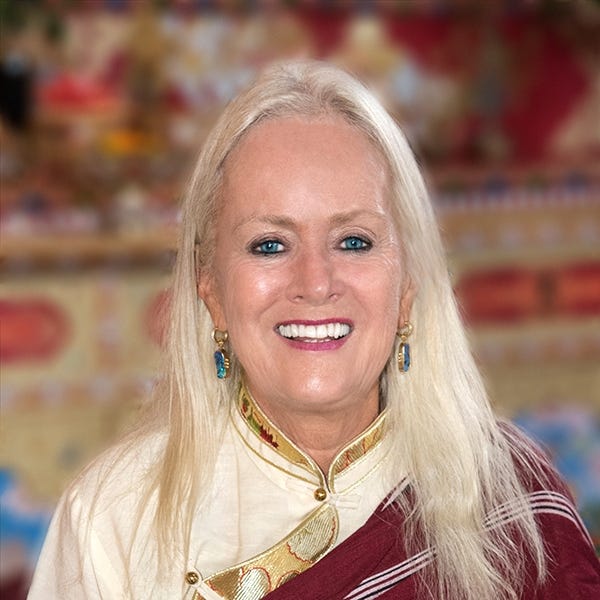How the West Will Be Won
It's not really about winning, but what's the future for Buddhism in North America?
Do I contradict myself? Very well then I contradict myself, (I am large, I contain multitudes.) -- Walt Whitman, Blades of Grass
Did Eastern Mysticism influence Whitman as he wrote those words? Maybe, but contradiction is not unknown in Western religious thought. The Abrahamic God is omniscient, omnipotent, and loving — and allows innocent people to undergo torture and starvation, for example. Some Christians go so far as to believe that the souls of unbaptized infants are condemned to eternal hell by that loving God.
What philosophers call the Law of Noncontradiction (LNC) — the principle that contradictory statements cannot both be true in the same sense at the same time — has been a cornerstone of Western logic. Aristotle (384-322 BC) was an influential early proponent.
When I decided to write about Buddhism coming to the West, I assumed that LNC was a big stumbling block. As I researched the subject, however, I learned that the world of philosophy is divided on whether Western cultures actually accept LNC more than Eastern ones do.
That led me to think about Nagarjuna (circa 150-250), who played a role in Buddhist philosophy similar to Aristotle’s in the West. He also applied firm rules of logic to teachings that might be considered contradictory, such as this one from the Heart Sutra:
…(F)orm is no other than emptiness, emptiness no other than form. Form is exactly emptiness, emptiness exactly form.
If you’re a nerd and want to understand how Nagarjuna reconciled the seeming contradiction above, see The Fundamental Wisdom of the Middle Way, translated by Jay Garfield. I won’t tackle his explanation here. For a less nerdy guide to the seeming contradictions in the Heart Sutra, read Anam Thubten’s The Fragrance of Emptiness.
Maybe East and West use similar logic, but their cultural traditions lead them to tolerate different apparent contradictions.
A trait of Buddhism, indisputably a contradiction, is this: Billions of words have been spoken and written to help us reach enlightenment, a state that can’t be put into words.
Consider how Sogyal Rinpoche explained it:
When you look into a mirror, you see your reflection. But you are not the reflection. Likewise, words and teachings are only reflections of the truth, not the truth itself.
We educated Westerners who tend to get drawn to Buddhism love to get lost in words. That may be the hardest obstacle for us to overcome. While a core goal in Vajrayana Buddhism is to know one’s own mind, the knowing is not intellectual. It’s an experiential knowing that can’t be expressed to others.
And here I am writing more words to make that point.
What may seem like a contradiction in Buddhism is the way we talk about the self.
On one hand, we call the self empty — an assemblage of component parts that changes from moment to moment, with no fixed, stable presence. We compare the self to a wave in the sea, which may appear different from other waves but is ultimately made of the same water and returns always to the sea.
On the other hand, we see ourselves as part of a community (sangha) along with other selves, and we pray to bring metta (loving-kindness) to others as well as ourselves.1
The resolution of that apparent contradiction applies to many other questions Westerners may have about Buddhism. We’re talking about two levels of reality.
Absolute reality is a state we learn about and may occasionally reach in meditation but don’t fully live in until we are fully enlightened. This is where we know — not intellectually but experientially — that we are the sea and not the wave.
Relative reality is the world we perceive and live in from day to day.
When I say the meta prayer, it is for us in relative reality.
In the world, as you and I experience it, we cannot exist in a state of absolute reality. As a Buddhist, I know that the chair I’m sitting in as I write this has no fixed, stable presence. In other (Buddhist) words, it’s empty. But I’m also pretty certain that the chair will continue to support me. You and I have no fixed, stable presence, but in this world — in relative reality — we can’t merge our bodies or our minds.
If I went around afraid that my chair wouldn’t continue to support me and that you and I could merge, I’d most likely end up hospitalized or homeless.
But Buddhism always has a middle way. We learn to go about our business respecting both the absolute and relative realities.
Lama Tsultrim Allione is among the hundreds of Westerners — women as well as men — who traveled to the East over the last 75 years, spent years and decades studying with masters, and returned to the Americas to teach. Her biography is both typical and extraordinary. (How’s that for a contradiction?) Significant numbers of Asians have come West to teach the dharma over the last century and a quarter.
Even so, the progress of the faith has been slow. Cultural differences are part of the reason.
Western culture, as we all know, emphasizes personal freedom over familial or group obligations. That may seem to conflict with the role of the teacher and the sangha in Buddhism or the practice of guru yoga, which I hope to discuss in a future post.
The Eastern cultures that have spawned Buddhism tend to be highly patriarchal and rigid as well as private about scandals. In a recent Edge of Mind podcast, Andrew Holecek interviewed Lama Palden Drolma candidly about the cultural problems involved in importing Buddhism to the West.
What’s clear to me is that we need a new generation of teachers — Westerners with extensive Buddhist training and Easterners with a good understanding of Western culture. Statistics on Buddhism in North America are hard to pin down. The number of Buddhists here is still small (estimated at 1% to 5% of the population) but seems to be growing.
Buddhism changes as it adapts to new cultures, but it will take many more decades before we know what Western Buddhism looks like.
I am grateful to all my readers and subscribers. To share this post with others, click on the button below.
If you want to become a subscriber, click the button below and choose the free option. You should buy a paid subscription only if you find value in my words, decide to support my work, and can afford $5 a month or $50 a year. Free subscribers receive the same content as paid subscribers.
Instead of a musical bonus today, here’s an 11-minute teaching from Yongey Mingyur Rinpoche, who I believe has the youth, wisdom, and personality to be a major influence on Western Buddhism. I’ll probably say more in future posts about his growing audience in the West. In the meantime, this example shows how he skillfully weaves Buddhist concepts into a talk on everyday life that transcends cultural differences.
Another question might fit here: “How can there be reincarnation if there’s no self to be reborn?” The answer to that one will have to await a future post.






